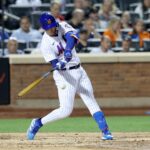
In the second round of the MLB draft on Thursday, the Mets passed on Stanford outfielder Austin Wilson. Wilson would have been a risky selection, but he also had a very high upside. Instead the Mets drafted high school pitcher Andrew Church. Church could turn out to be solid pick in the future, but I feel the Mets made a mistake passing on Wilson.
Austin Wilson is an extremely talented outfielder, and he had one of the highest ceilings in this year’s draft class. Wilson was considered a consensus first round pick leading up to the draft. He stands at 6’5” 245 pounds, he possesses great power, and he also has a very strong throwing arm. He even has decent speed for a man his size. However, Wilson also carried a lot of risk because of concerns over his swing.
Wilson went to college at Stanford, which has a poor reputation for developing hitters. Many scouts criticize Stanford for their hitting approach, which encourages contact and line drives over home runs. Analysts say it may take a long time for him adjust his swing, and it is uncertain if he could ever fulfill his power potential.
Despite the concerns over Wilson’s swing, I believe the Mets still should have selected Wilson in the second round. Since there are so many second round picks that never even reach the majors, every player available in that spot carried a lot of risk as well. So, my argument is, why not draft the player who had the highest upside? Wilson undoubtedly had the highest upside of any player available. Wilson also would have been a good fit for the system. The Mets desperately need a right handed outfielder with power, and that is exactly what Wilson will be if he fulfills his potential.
While Wilson’s swing is concerning, how big of a concern is it? I’ve decided to research the Stanford hitting philosophy further. According to Stanford’s associate head Coach Dean Stotz, there is a misconception about Stanford’s hitting philosophy.
“We don’t have one hitting philosophy, or a cookie-cutter approach,” Stotz said. “We do encourage our hitters to use the middle of the field. We try to get them to stay on balance. We have a lot of confidence in our strength and conditioning program, and we try to get strong.”
“But we’ve had a lot of different hitters do it a lot of different ways. Carlos (Quentin) tinkered, and his junior year, he hit about the way he does now. Garko was all spread out and used his strength.”
He goes onto to say:
“Mark does not clone people,” Stotz said of his boss, whom the players all just call Nine. “We’ve been here long enough that we know what we’ve got; we’re confident enough in who we are that we don’t have to do that. Tyler Gaffney has an ugly swing, but it works for him. Sean Ratliff (now in the Mets system) had an almost Japanese approach. Piscotty and Ragira are low-maintenance guys, though. They understand what the ball’s telling them. That’s what we want out of our hitters; the flight of the ball after they hit it tells them what they are doing right.”
Despite the criticisms of their hitting philosophy, there are some notable major league hitters that played at Stanford. They include, Carlos Quentin, Jed Lowrie, John Mayberry Jr, Jason Castro and Ryan Garko. For a player’s perspective, here’s what Astros’s starting catcher Jason Castro had to say when asked about Stanford’s hitting philosophy:
“A lot of the things that they teach are to get on top of the ball, and to hit the ball hard on a line and not try to worry about home runs, and things like that; those things will come. They’re also big on getting your foot down early, making sure you’re seeing pitches, and making sure you’re balanced. Definitely coming into pro ball now, and seeing guys that throw a little harder on a daily basis, those types of things have kind of helped me in the transition from college baseball to professional.”
Jason Castro is currently hitting .271, with 8 homeruns and 20 RBI. Castro also has the 4th highest slugging percentage among major league catchers.
So, the Stanford hitting philosophy certainly hasn’t hindered Castro’s career, and it also hasn’t hindered the career of Padres slugger Carlos Quentin. Quentin is a two time all-star, and he has smashed 144 home runs during his major league career.
If those players can have success despite going to Stanford, then why can’t Wilson? It is true that Wilson is a risk and he will have to make adjustments. However, in the second round I feel the reward outweighed the risk. In my opinion, the Mets missed a great opportunity to draft potential impact hitter at a great value.















